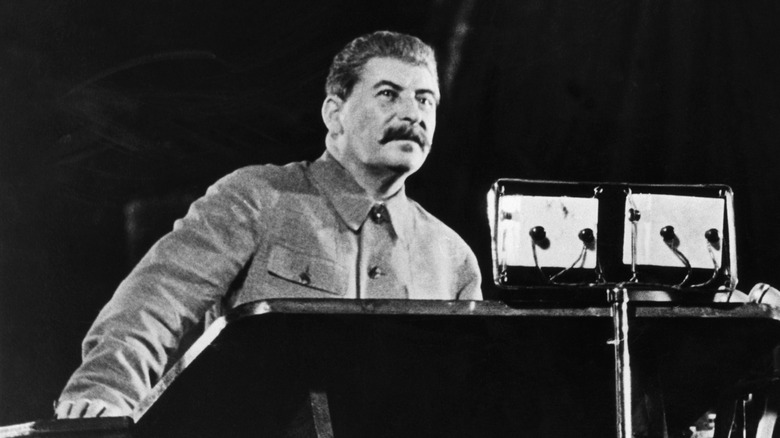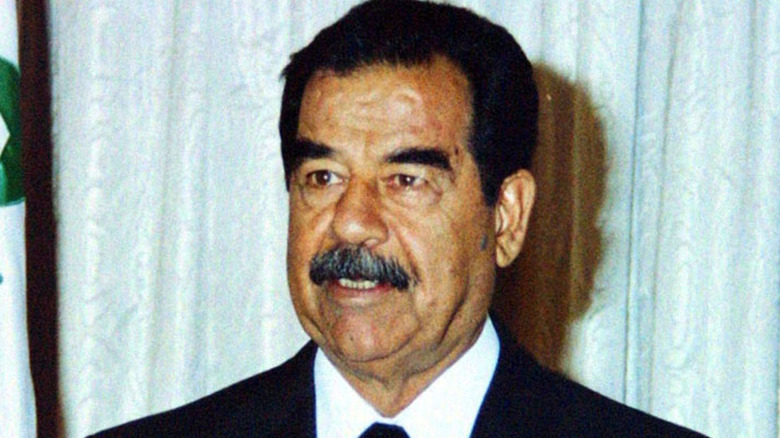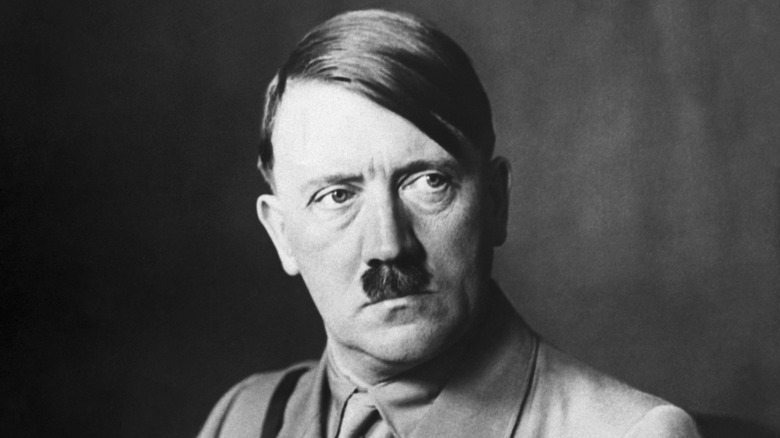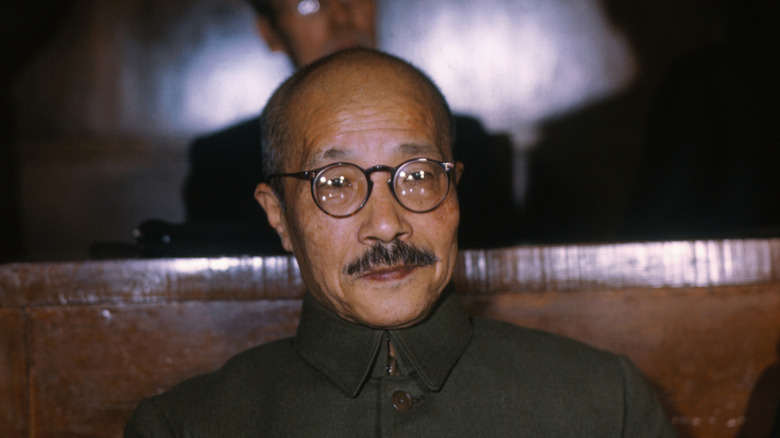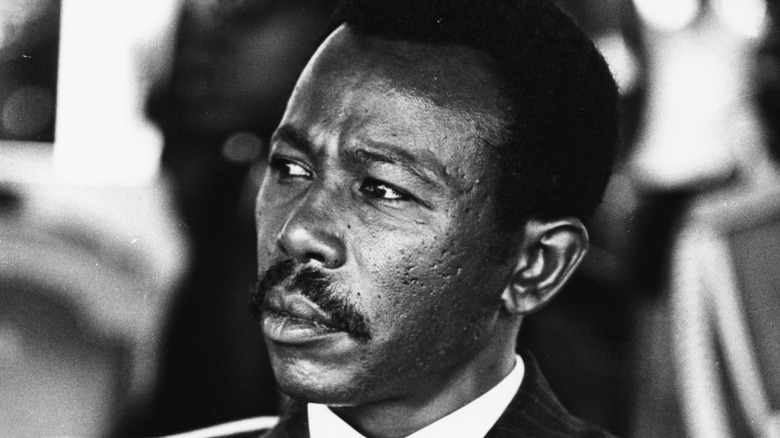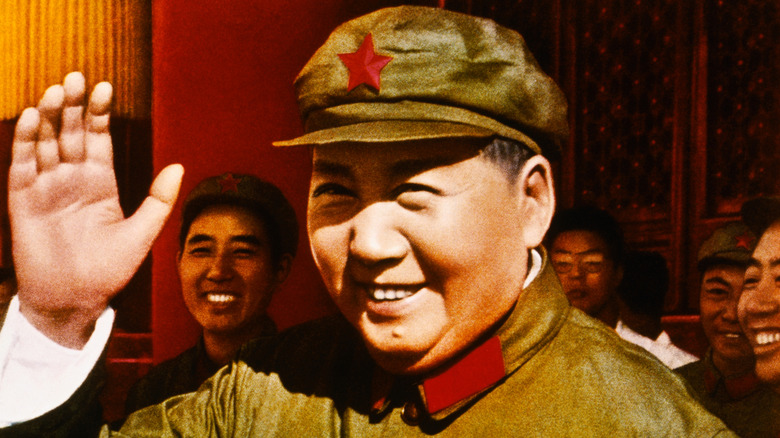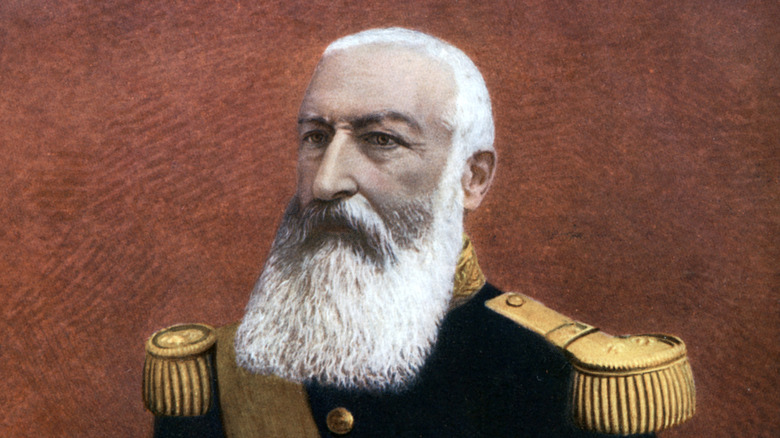The Deadliest World Leaders In Modern History
Perhaps it's a result of it being the first century to be extensively observed and documented through the use of contemporary technology, but the 20th century on the whole is one of the most violent, oppressive, and cruelest eras in history. As the world's political climate changed rapidly, moving from a time of monarchs, empires, and colonialism to democracies and independent rule, humans waged the messed-up World War I, the far worse World War II, too many other deadly armed conflicts, and so many famines and genocides that it's even hard to comprehend.
Those wars, the systematic torture, oppression, and murder of millions, as well as the genocides, are definitely the handiwork of a handful of the 20th century's most feared and depraved political leaders. Dictators, presidents, and kings, they all actively worked to murder and destroy in the name of a political ideology or to serve their own needs. Some are even worse than others, but here they are: the world leaders responsible for the most deaths since the turn of the 20th century.
Idi Amin
A trusted advisor of Ugandan president Milton Obote, Idi Amin had become the head officer of the country's military by 1966. Amin used those forces, along with violence and intimidation, to solidify Obote's control, then he took advantage of Obote being away from Uganda to launch a military coup in 1971. Alleging a corrupt government that needed to be ousted, Amin was viewed favorably across Uganda, until he started earning his nickname "The Butcher of Uganda."
The self-declared president and power-consolidating dictator acted quickly to round up political adversaries, supposed enemies, members of ethnic and cultural groups that weren't his own, judges, religious figures, and intellectuals, so that they could be incarcerated, tortured, and killed. Amin's clandestine police organization, the State Research Bureau, carried out the violence at its torture and execution centers. Amin killed as many as 500,000 of his own people between 1971 and 1979, when he was ousted by an invasion from Tanzania that included expelled Ugandans, and then forced into asylum in Saudi Arabia.
Joseph Stalin
Joseph Stalin was a man of many identities. After becoming a Marxist, Joseph Dzhugashvili changed his name to Stalin — "man of steel" — and in 1917 served the revolutionary Bolsheviks as the editor of the communist newspaper Pravda when the party overthrew the Tsar of Russia and slaughtered the monarch and his family. Then general secretary of the Communist Party, Stalin succeeded Vladimir Lenin to become dictator of the Soviet Union by 1929. He put into place a plan to isolate, industrialize, and modernize the country, and those who failed to reach high production quotas or opposed Stalin in any way were imprisoned in the Gulag prison system in remote Siberia, or summarily executed.
When Stalin's government collectivized and nationalized the farms, farmers held back grain and livestock in protest. Five million people died from the ensuing famine, and Stalin eradicated the farmers. Obsessed with rooting out anyone who could be part of the opposition in the 1930s, Stalin had 93 of his 139 Central Committee members and 81 of 103 military leaders executed. Bolstering an environment of reporting and paranoia, 3 million so-called communist opponents were identified and sent to the Siberian gulags, where 750,000 died. By the time he died in 1953, Stalin was directly linked to the deaths of 20 million people.
Saddam Hussein
Saddam Hussein was even more evil than commonly thought. He made his political debut in 1959 with an assassination attempt on Iraq's military head of state, then rose through the ranks of the Ba'ath Party to become vice president and head of the secret police. Finally, in 1979, Hussein became Iraq's dictatorial president. At one of his first cabinet meetings, he deemed some advisors traitors and personally executed 22 officials, forcing those who were spared to assist him. That abject terror would define the regime of Saddam Hussein until he was removed from office, tried, and executed after a 2003 invasion of Iraq by U.S.-led forces.
From 1980 to 1988, Hussein waged a war with Iran that left 800,000 people dead across both countries. Domestically, the paranoid and punishing Hussein locked up hundreds of thousands of perceived enemies via the brutal secret police system. He also established a network of prisons that were hidden in plain sight, disguised as hotels and athletic facilities. Those indefinitely held were subjected to constant torture, and the number of prisoner deaths that Hussein advocated may have been as high as 200,000.
One such brutal instance occurred in 1999, in response to a prison overcrowding issue, when Hussein reduced the population via mass executions of inmates. Hundreds of thousands more of Hussein's political enemies were never tried or imprisoned for their crimes, for which they were killed in their homes or on the streets along with their entire families.
Adolf Hitler
His name is synonymous with evil, and he's a viable candidate for the worst person who ever lived: Adolf Hitler murdered in shockingly huge numbers and with unflinching and open cruelty. After staging a violent coup in which he took over Germany and installed the Nazi Party, Hitler endeavored to take over Europe and institute his dogma of race theory. Convincing an economically crushed post-World War I Germany that its problems were the fault of Jewish people, Hitler and the Nazis orchestrated the biggest extermination attempt in recorded history.
As it rampaged through Europe with its well-equipped military, the Nazis destroyed and took over local governments and would enact doctrines like its "Final Solution." The Nazis gathered up all groups declared undesirable: LGBT people, Roma, and most of all, Jewish people. Wherever the Nazis conquered, resident Jews would be sent to labor camps or concentration camps, where they would be worked to death, physically and psychologically tortured, experimented upon, or killed in toxic gas chambers. Hitler's holocaust decimated the Jewish presence in Europe: 6 million Jews were murdered, and Hitler's final death toll approached 11 million.
Hideki Tojo
By 1937, Hideki Tojo had risen through the Japanese imperial military to the rank of chief of staff of the Kwantung Army in Manchuria (located in what is now Northeast China). He was a prominent military leader when Japanese forces invaded China in 1937: during a six-week-long period known as the Nanjing Massacre, Tojo's forces violently sexually assaulted as many as 80,000 women, and then killed some of the victims. The Japanese military laid waste to the city of Nanjing, then left only under-resourced reserve troops to defend it, and around 300,000 people died.
Elevated to prime minister of Japan in 1941, Tojo directed the country's World War II efforts, attempting to dominate Asia and escalating the war by pulling the U.S. into combat with the bombing of the military base at Pearl Harbor in Hawaii. Japanese wartime atrocities, committed by the military under the authority and approval of Tojo, amounted to between 3 million and 10 million casualties. As many as 6 million Chinese people were killed by Tojo's Japanese military, along with those from Indonesia, Korea, and the Philippines, as well as prisoners of war from Europe and the U.S. After the Japanese surrender that ended World War II, Tojo was among seven high-ranking government officials tried for war crimes, for which he was found guilty and executed.
If you or anyone you know has been a victim of sexual assault, help is available. Visit the Rape, Abuse & Incest National Network website or contact RAINN's National Helpline at 1-800-656-HOPE (4673).
Pol Pot
Between 1970 and 1973, the U.S. was executing bombing raids on rural Cambodia during the Vietnam War. It was with this backdrop that Pol Pot and the communist Khmer Rouge built a nationalist, isolationist movement, one that would provide tacit approval and do the dirty work when the party took over the country in 1975, rechristening it Democratic Kampuchea.
Pol Pot held that capitalist and Western ideals had spoiled the population, and he used extreme, systematic, and appalling violence to purge the country of those theories and anyone who opposed him. Intellectuals, Christians, Buddhists, and Muslims were persecuted, imprisoned, and/or slaughtered, while those who remained were forced to live in communes and submit to re-doctrination programs. Pol Pot aimed to create what he thought was the ideal communist society: rural and agrarian. In that experiment, 1975 became "year zero" as urban dwellers were sent to work on farms while all private property was confiscated and socialized.
By being worked to death, tortured, starved, or killed by the military for refusing re-education or minor infractions, a total of 1.7 million Cambodians died at the hands of Pol Pot's Khmer Rouge. Countless thousands died in detention centers, as well as in the "killing fields" around the communes. The routine deaths to serve the engine of revamping Cambodia to adhere to his own notion of communism ended in 1979, when Vietnam expelled Pol Pot and installed a sympathetic government.
Mengistu Haile Mariam
After hundreds of years, the monarchical system of government ended in Ethiopia in June 1974, when rogue military members who were unhappy with their funding and career opportunities deposed Emperor Haile Selassie I. Before the coup, rebellion participant and staunch Marxist Mengistu Haile Mariam had been named head of the now-ruling Dergue, or the Armed Forces Coordinating Committee. Afterward, he became vice chair of the Provisional Military Administration Council, which was responsible for day-to-day government actions. Fully entrenched with unchecked power by November 1974, Mengistu had his superior at the PMAC assassinated, as well as 60 high-ranking members of the Selassie administration. After an attempt by a more moderate contingent to unseat him in 1977, Mengistu consolidated power and launched the Red Terror Campaign. His followers carried out orders to brutally murder anyone suspected of opposing the dictator, and then left the bodies in the streets.
As part of his communist takeover, Mengistu forced huge swaths of the population to relocate, and ordered the nation's agricultural and farm production facilities to be nationalized. That left the Ethiopian economy already destabilized by the time droughts and famine hit in the 1980s. What little food Ethiopia had, and what was sent by international humanitarian aid projects, was withheld from the people on Mengistu's orders. The military received the most abundant shares while the rest was used as a weapon, distributed by the army as a tactic to quell uprisings.
Forced out of Ethiopia by the opposition and into Zimbabwe in 1991, Mengistu and his cohort faced 12 years of trials. In 2007, Mengistu was found guilty in absentia of genocide. An estimated 50,000 Ethiopians died in the forced relocations, another 150,000 civilians were killed, and 600,000 starved to death.
Mao Zedong
It's part of the messed-up truth of Mao Zedong that he intended for the Great Leap Forward to reinvent China, both as an idyllic communist dystopia and a world leader in industrial production. Instead, it led to the biggest famine in recorded history. Chairman Mao, head of the Chinese Communist Party and the People's Republic of China since 1949, wanted China to attain in less than half a decade what other superpowers had taken decades to do: become a superpower through an industrial revolution built on steel manufacturing. Tens of millions of farmers and rural dwellers were conscripted into mine work and to construct crude clay smelting furnaces. Not only did the mining operations yield little usable ore, but the abandonment of large-scale farming led to less grain cultivation, severely impacting China's food supply. With a terrible drought also to blame, an estimated 30 to 38 million people starved to death from 1958 to 1961.
After the Great Leap Forward came Mao's Great Proletarian Cultural Revolution, which was meant to purge the CPC and China itself of anyone who wasn't on board with Mao's plans. Millions of identified enemies of the government and party were kidnapped, tortured, murdered, and imprisoned courtesy of the Red Guard. When it was declared finished in 1969, between 500,000 and 8 million Chinese citizens had been killed by Mao's acolytes.
King Leopold II
Upon becoming king of Belgium in 1865, Leopold II launched a campaign of atrocities openly and brutally committed in the name of making his country an imperial and colonial power. After dispatching representatives to sign treaties with area chiefs in the Congo River basin, Leopold exerted full and singular control over a large portion of the Congo Free State from 1885 on, a private colony that functioned as a massive plantation, over which the king ruled.
In the 1890s, after killing untold elephants for ivory, Leopold turned his attention to rubber. An increasingly valuable commodity for its use in bicycle tires, automobiles, and industrial machinery, Leopold discovered vast numbers of wild rubber trees in the Congo. To harvest it, he sent his 19,000-member personal army into villages, where they would enslave local men. If the men didn't reach their increasingly high rubber quotas, their families would be killed. Using similar methods in lumber and other industries, the women held hostage died of starvation in great numbers while their husbands toiled to death in the forced pursuit of commodities.
Thousands rebelled by moving into the wilderness, where they died of exposure and starvation, while tens of thousands more died in rebellions put down by Leopold's soldiers. There were so few people left to farm and fish that the Congo experienced multiple deadly famines. All of that crushing brutality cut the population of the Congo from 20 million before Leopold arrived to 10 million by 1920.
Kim Jong-Un
With assistance from the Soviet Union, the communist North Korean Workers Party had completely taken control of North Korea by 1950, with Kim Il Sung as its supremely powerful leader.
Il Sung set into place the secretive and strongly authoritarian practices by which North Korea would be governed after control passed to his son, Kim Jong Il, upon his death in 1994, and then his grandson, Kim Jong Un, in 2011. While his predecessors were known for human rights violations and numerous atrocities, Kim Jong Un may be the most brutal of the Kim dynasty. Severe punishments for acts deemed offensive to the state are a matter of course in Kim Jong Un's North Korea.
In 2013, he accused his high-ranking uncle, Jang Song Thaek, of corruption and treason, ordered his execution, then showed off the body to surviving top officials. After 1,000 people died in flooding in 2024, the 30 state officers who were blamed were executed in public, and hundreds more government and military officials were killed under similar circumstances. South Korean TV is forbidden in North Korea, and when two teenagers were caught watching such shows in 2022, they were executed. Then there are the many prisoners held in labor camps situated around North Korea, where as many as 120,000 of Jong Un's purported enemies are serving sentences under terrible conditions, including torture.
Enver Pasha
In the waning years of the once mighty Ottoman Empire, the land was ruled by the "Three Pashas," including Minister of War Enver Pasha, a crucial figure in the Young Turk Revolution of 1908 that eliminated a controlling sultanate in favor of what was ostensibly a parliamentary democracy. Allied with Germany, Pasha brought the Ottoman Empire into World War I in 1914, but lost an early battle to Russia in Sarikamish. Pasha believed that Armenians in the region had tipped the scales against the Ottomans, a theory that led to the tragic 20th-century Armenian genocide.
After a few hundred intellectuals were arrested and killed, a propaganda campaign painted Armenians as enemies of the state. Consequently, the culturally distinct group was decimated in the Ottoman Empire: Pasha's squads reduced the population from 2.1 million to 388,000, including large-scale massacres from 1920 to 1923. Armenians were murdered en masse, or they died from forced labor, in concentration camps, and on marches across the deserts of Syria.
Pasha oversaw two more genocides within the borders of the Ottoman Empire, both faith-based. The mass killing of Christian Assyrians by the Islamic ruling forces from 1915 to 1923 left 300,000 dead, and 350,000 Christians were killed, too, the result of Turkish invasions of Greek cities.
